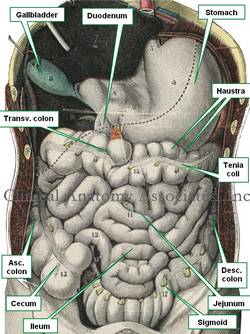The word [peritoneum] has a Greek origin [περίτόνοςαιον]. Loosely translated it has the prefix [peri-] meaning "around", the root [-ton-] from the Greek [tonos], meaning "to stretch", and the suffix [-eum] meaning "a membrane". It is "a membrane that is stretched around".
The peritoneum is a thin serosal membranous sac found in the abdominopelvic cavity. Histologically it is composed of a layer of mesothelium supported by a layer of connective tissue. Being a serosal sac, it contains in its interior a small amount of peritoneal fluid. The pathological accumulation of peritoneal fluid is called ascitis.
Although the peritoneum is one continuous membrane, and because of its relation to the organs and the abdominal wall, the peritoneum is described as formed by two components:
• Parietal peritoneum: The parietal peritoneum is that portion of the peritoneal sac related to or in contact with the walls of the abdomen and the pelvis.
• Visceral peritoneum: The visceral peritoneum is that portion of the peritoneal sac related to or in contact with the abdominopelvic viscera. I this case the peritoneum encases the viscera almost completely and is referred to as their serosa layer i,e: serosa layer of the ileum.
The double-layered portions of the peritoneal sac that stretch between organs or between organs and the abdominal wall are known by different names. They can be called an abdominopelvic [ligament], a [mesentery], a [meso..(something)], or an [omentum]. These structures are covered in separate articles. Some of these structures are:
- Falciform ligament: A sickle-shaped double fold of peritoneum related to the liver
- Ligament of Treitz: Also known as the "suspensory ligament of the duodenum"
- Infundibulopelvic ligament: A fold of peritoneum containing the ovarian arteries and veins
- Lesser omentum: The lesser omentum is one of the two double-folds of peritoneum related to the stomach
- Mesosigmoid: A double peritoneal membrane related to the sigmoid colon
- Transverse mesocolon: A double peritoneal membrane related to the transverse colon
- Mesoappendix: A double peritoneal membrane related to the vermiform appendix, etc.
Sources:
1. "Clinically Oriented Anatomy" Moore, KL. 3r Ed. Williams & Wilkins 1992
2. "The origin of Medical Terms" Skinner, AH, 1970
3. "Tratado de Anatomia Humana" Testut et Latarjet 8 Ed. 1931 Salvat Editores, Spain
Image modified from the original from Testut and Latajet, 1931. Public domain.
Thanks to Dr. Randall Wolf for suggesting this article




